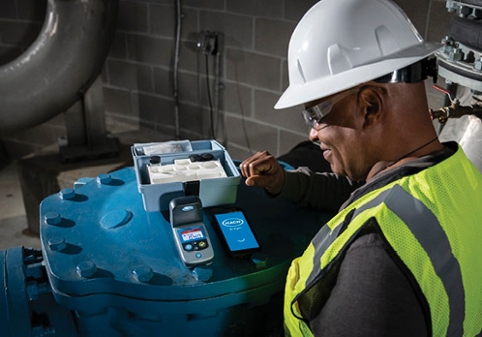-
PRODUCTS
- Lab Instruments
- Lab Meters and Probes
- Chemistries, Reagents, and Standards
-
Online Analyzers
Ammonium Analysers Ammonia Monochloramine Chlorine Analyzers
- CL17sc
- CL10sc Amperometric
- 9184 sc Amperometric
- เครื่องวิเคราะห์คลอรีนด้วยการวัดสี Ultra Low Range CL17sc
EZ Series Analysers- Iron
- Aluminium
- Manganese
- Phosphate
- Chloride
- Cyanide
- Fluoride
- Sulphate
- Sulphide
- Arsenic
- Chromium
- Copper
- Nickel
- Zinc
- Ammonium
- Total Nitrogen
- Total Phosphorus
- Phenol
- Volatile Fatty Acids
- Alkalinity
- ATP
- Hardness
- Toxicity
- Sample Preconditioning
- Boron
- Colour
- Nitrate
- Nitrite
- Silica
- Hydrogen Peroxide
- EZ Series Reagents
- EZ Series Accessories
- EZ sc Series Inorganics
- EZ sc Series Metals
- EZ sc Series Nutrients
-
Online Sensors and Controllers
Ammonium Sensors Conductivity Sensors
- 3400 Analogue Contacting
- 3400 Digital Contacting
- 3700 Analogue Inductive
- 3700 Digital Inductive
- 9525 DCCP System
- Industrial UV
- Flow and Collections
- Automated Lab Systems
- Test Kits & Strips
- Microbiology
- Lab Equipment and Supply
- Samplers
- Electrochemistry
- PARAMETERS
- APPLICATIONS
- INDUSTRIALS
- E-SHOP
- Service
- BRANDS
Hach Thailand
เลือกประเทศหรือภูมิภาคของคุณ:
Europe
Americas
Asia - Australasia
- Australia
- Mainland China
- India
- Indonesia
- Japan
- Malaysia
- New Zealand
- Philippines
- Singapore
- South Korea
- Thailand (Thai)
- Taiwan
- Vietnam
Middle East - Africa
Chemistries ONLINE SHOP: +6693 769 9254
Portable Pocket and Handheld Colorimeters
การทดสอบน้ำที่รวดเร็วและง่ายดายสำหรับสภาพแวดล้อมที่มีความต้องการมากที่สุด
Hach ® ได้พัฒนาเทคโนโลยีการวัดสี โดยนำเสนอเครื่องวัดแบบพกพาที่มีความแม่นยำสูงและมีประสิทธิภาพสูง เพื่อใช้วิเคราะห์พารามิเตอร์คุณภาพน้ำที่สำคัญ เช่น คลอรีน เหล็ก แมงกานีส ซีโอดี โอโซน และฟอสเฟต และอื่นๆ
เหมาะสำหรับการใช้งานที่หลากหลาย
- น้ำดื่ม
- น้ำเสียเทศบาล
- น้ำในโรงงานอุตสาหกรรม
- การผลิตไฟฟ้า
- อาหารและ เครื่องดื่ม
- การผลิตเคมีภัณฑ์
- และอื่น ๆ


Colorimeter Analysis Technology
Achieve precise water quality analysis with Hach's user-friendly, durable, portable colorimeters. Choose from single-parameter or multiparameter, up to multi parallel parameter devices.
*Products may not be available in all countries.
ประเภทของคัลเลอริมิเตอร์
คัลเลอริมิเตอร์แบบพกพาที่ใช้งานง่าย ทนทาน และพกพาสะดวกของ Hach สร้างขึ้นเพื่อรับมือ ความยุ่งยากในการทดสอบคุณภาพน้ำ
ไม่ว่าคุณกำลังมองหาอุปกรณ์ทดสอบพารามิเตอร์ตัวเดียวหรือคัลเลอริมิเตอร์แบบพกพาที่มีสามารถวัดได้หลายพารามิเตอร์ที่ซับซ้อน Hach มีโซลูชันที่จะช่วยรองรับความต้องการของคุณ ด้วยรีเอเจนต์คุณภาพและขั้นตอนการทดสอบที่เรียบง่าย
* ผลิตภัณฑ์บางรายการอาจไม่มีจำหน่ายในบางประเทศ

Pocket Colorimeters
DR300
การวิเคราะห์ภาคสนามอาจทำได้ยาก และต้องใช้เครื่องมือที่ถูกออกแบบมาให้ทนต่อสภาพสนาม คัลเลอริมิเตอร์แบบพกพาให้ผลลัพธ์ที่เชื่อถือได้และแม่นยำ ตัวเครื่องได้ออกแบบมาตามหลักสรีรศาสตร์ กระทัดรัด ง่ายต่อการใช้งาน
Hach DR300 เป็นคัลเลอริมิเตอร์แบบ single-parameterพารามิเตอร์หลายแบบให้เลือก โดยตัวเครื่องยังคงรักษามาตรฐานความน่าเชื่อถือของ Pocket Colorimeter
พร้อมจอแสดงผลที่ใหญ่ขึ้นและ Black Light ที่ได้รับการพัฒนา ทำให้การอ่านค่าง่ายยิ่งขึ้น

Multiparameter Colorimeters
DR900
คัลเลอริมิเตอร์มือถือ แบบหลายพารามิเตอร์มีไว้สำหรับผู้เชี่ยวชาญด้านคุณภาพน้ำที่ต้องการทดสอบพารามิเตอร์สีเป็นจำนวนมากในสภาพแวดล้อมที่สมบุกสมบัน
คัลเลอริมิเตอร์แบบพกพา Hach DR900 ช่วยให้เข้าถึงวิธีทดสอบคุณภาพน้ำที่ต้องวิเคราะห์บ่อยที่สุดได้อย่างรวดเร็วและง่ายดายเพียงไม่กี่คลิก
คัลเลอริมิเตอร์รุ่นนี้ ผ่านการทดสอบการตกกระแทก รวมถึงตัวเครื่องยังสามารถ กันน้ำ กันฝุ่น ง่ายต่อการใช้งาน มีพื้นที่จัดเก็บข้อมูลขนาดใหญ่ และพอร์ต USB ในตัวสำหรับการถ่ายโอนข้อมูลอย่างง่ายดาย
Frequently Asked Questions
What is a Colorimeter?
A colorimeter is a light-sensing instrument that measures how light is absorbed and transmitted as it moves through a liquid sample.
Colorimeters follow the principles of the Beer-Lambert Law (Beer’s Law), which is the linear relationship between absorbance and concentration.
To analyze a specific analyte in a liquid sample, color-forming reagents are added. The color reaction is proportional to the concentration of the analyte.
High concentrations will absorb more of the light than a solution with a diluted concentration.
How is a colorimeter constructed?
A colorimeter typically consists of several key components assembled to measure the absorbance or transmittance of light through a sample.
Light Source: This emits specific wavelengths of light, usually in the visible spectrum, directed towards the sample.
Sample Holder: A compartment where the sample is placed for analysis. It ensures consistent positioning and presentation of the sample to the light source and detector.
Filters or Monochromators: These components allow only certain wavelengths of light to pass through to the sample, ensuring precise measurement of specific colors or wavelengths.
Photodetector: This detects the intensity of light either transmitted through the sample or reflected from it. Common types include photodiodes or photomultiplier tubes (PMTs).
Amplifier and Signal Processor: This circuitry amplifies and processes the signal from the photodetector, converting it into a measurable output such as absorbance or transmittance.
Display and Controls: A user interface to adjust settings, view results, and control the operation of the colorimeter.
These components work together to provide accurate and reliable measurements of the color properties of a sample.
Is there a way to prevent measurements from being saved automatically by the DR900 Multiparameter Portable Colorimeter?
Yes, there is a way to prevent measurements from being saved automatically on the DR900 Multiparameter Portable Colorimeter. This can be done by disabling the auto-save feature in the device settings. Typically, you can access the settings menu on the colorimeter's interface and navigate to the data storage or data management section. From there, you should be able to find an option to toggle the auto-save function on or off. By turning off auto-save, the colorimeter will no longer save measurements automatically, allowing you to manually save or discard measurements as needed during your testing process.
To prevent data from being automatically stored onto the DR900, simply turn off the autosave feature. This can be done by selecting OPTIONS, then ADVANCED OPTION, then AUTOSAVE, and then OFF.
What is the principle of a colorimeter and what are its applications?
Principle:
A colorimeter operates on the principle of Beer-Lambert law, which establishes a direct relationship between the absorbance of light by a solution and the concentration of the solute, as well as the path length of light through the solution. The functioning of a colorimeter involves several steps:
- A colorimeter emits specific wavelengths of light, typically within the visible spectrum, towards the sample.
- The sample, which can be a liquid or a solid dissolved in a solvent, is placed in a sample holder. The light either passes through the sample or is reflected from it.
- A photodetector measures the intensity of the light that passes through the sample or is reflected from it. This measurement is then compared to a reference measurement, often the intensity of light passing through a blank solvent, to determine the absorbance or transmittance of the sample.
- The absorbance or transmittance values obtained are converted into concentration measurements using calibration curves or mathematical formulas based on the Beer-Lambert law.
Applications:
Colorimeters are versatile instruments with a wide range of applications across various industries and scientific fields:
- Chemical Analysis: In chemistry labs, colorimeters are utilized to determine the concentration of chemical solutions by measuring their absorbance at specific wavelengths.
- Environmental Monitoring: They play a crucial role in environmental science for monitoring water quality, analyzing pollutants, and measuring the concentration of nutrients in soil and water samples.
- Food and Beverage Industry: Colorimeters are essential tools for assessing the color, purity, and concentration of ingredients in food and beverages, ensuring quality control and consistency in production processes.
- Clinical and Biological Research: In biology and medicine, colorimeters find applications in enzyme kinetics studies, protein quantification, and drug analysis, among others.
- Industrial Quality Control: Colorimeters are instrumental in maintaining product standards and consistency across various industries such as pharmaceuticals, textiles, paints, and cosmetics, through rigorous quality control processes.
- Overall, colorimeters serve as indispensable instruments for quantitative analysis and quality assurance in a wide range of scientific, industrial, and commercial applications.
What are handheld colorimeters by Hach, and what are their features?
Handheld colorimeters by Hach are portable devices designed for convenient and accurate colorimetric analysis in various industries and applications. Here are some key features:
1. Portability: Hach handheld colorimeters are compact and lightweight, allowing for easy transport and use in the field or laboratory.
2. User-Friendly Interface: They feature intuitive user interfaces with easy-to-read displays and simple navigation buttons, making them accessible to users with varying levels of expertise.
3. Wide Range of Parameters: Hach offers handheld colorimeters capable of measuring a wide range of parameters, including but not limited to:
4. Calibration and Data Storage: These colorimeters typically allow for calibration with known standards to ensure accurate measurements. They also often include internal memory for storing measurement data, enabling easy retrieval and analysis.
5. Durable Construction: Hach handheld colorimeters are built to withstand harsh environmental conditions, with rugged housing and durable components for reliable performance in the field.
6. Battery-Powered Operation: They are powered by batteries, offering flexibility and convenience for use in remote locations or areas without access to power outlets.
7. Compliance and Certifications: Hach handheld colorimeters may comply with industry standards and regulations, ensuring that measurements meet quality control and regulatory requirements.
Overall, Hach handheld colorimeters DR900 and DR300 provide users with a portable, reliable, and efficient solution for on-site colorimetric analysis across a wide range of applications.
How Does a Colorimeter Work?
A colorimeter measures the concentration of a substance in a solution by detecting the amount of light absorbed by that substance. It works on the principle of colorimetry, where a sample is exposed to light of specific wavelengths. The colorimeter then measures how much light is absorbed by the sample, which is directly related to the concentration of the substance. The device typically uses filters to isolate different wavelengths and a detector to quantify the absorbed light, providing accurate measurements of the solution's color.
How to Interpret Colorimeter Results
Interpreting colorimeter results involves comparing the measured absorbance to a standard curve or known concentration values. Here’s how:
- Obtain a Calibration Curve: Use standards of known concentration to create a calibration curve.
- Compare Absorbance: Measure the absorbance of your sample and compare it to the calibration curve.
- Determine Concentration: Find the concentration corresponding to the measured absorbance on the calibration curve to interpret the results accurately.
What Does a Colorimeter Show?
A colorimeter shows the concentration of a substance in a solution by measuring the amount of light absorbed at specific wavelengths. This measurement is expressed as absorbance, which correlates to the concentration of the analyte based on the Beer-Lambert law.
What Does a Colorimeter Show in Diffusion?
In diffusion studies, a colorimeter can show changes in the concentration of a substance as it spreads through a medium. By measuring the absorbance of samples taken from different points or times, you can analyze how the concentration of the substance varies with diffusion and assess the rate and extent of diffusion in the medium.



